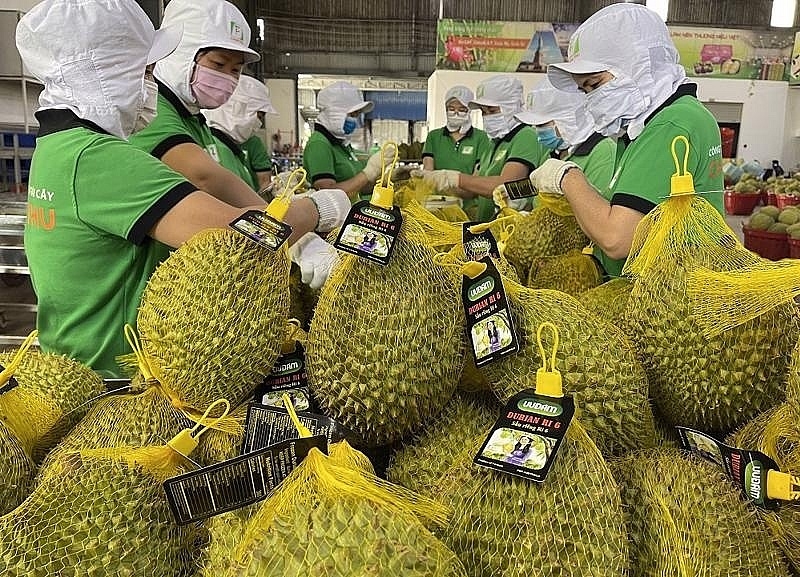Durian joins the "billion-dollar" export club
As one of Vietnam's key exported fruit products, durian, in the first seven months of the year, has witnessed remarkable growth in exports to the world's most populous market - China. The high demand in the Chinese market has elevated durian to become a top imported product in terms of both quantity and value.
 |
|
Building a truly sustainable industry chain is the greatest challenge for Vietnam's durian sector. Photo: Internet |
Joining the billion-dollar export club
According to a report from the Department of Cultivation (Ministry of Agriculture and Rural Development - MARD), from 2017 onwards, due to high prices and profitable production, durian has become a source of wealth for farmers in some provinces in the Mekong Delta such as Tien Giang, Vinh Long, Ben Tre, and Can Tho; in the Central Highlands like Dak Lak and Lam Dong; and in the Southeast region like Dong Nai and Tay Ninh. Farmers have rapidly expanded production areas by intercropping durian trees with fruit-bearing plants, especially by converting some rice fields to durian cultivation in the Mekong Delta. The durian cultivation area has significantly increased in the last five years. By the end of last year, the country had more than 110,000 hectares of durian, nearly triple the figure in 2017 (37,000 hectares). The average annual growth rate of durian cultivation area during this period was 24.5%. Thanks to this, Vietnam has risen to the third position globally in terms of durian cultivation area and production.
It's worth noting that even though Vietnam has recently entered the global market, its durian exports have reached a record high due to effectively seizing the opportunity after signing an export agreement for this product through official channels with China. In the first seven months of this year, durian exports have brought in US$1.1 billion, surpassing dragon fruit – the fruit that had topped the list of our country's exports for the last 10 years – to claim the leading spot and officially join the "billion-dollar export club" of the agriculture sector. The dynamic export also boosted durian prices in cultivation areas. A report on the production situation and price trends of certain agricultural products from the MARD showed that in July, the price of Ri6 durian increased by VND7,400/kg, reaching VND80,000/kg. Vietnam's durian exports for this year are projected to increase significantly, reaching US$1.2-1.5 billion, 3.5 times higher than last year.
Considering the Long Run
Prof. Dr. Tran Van Hau, former senior lecturer at Can Tho University and a leading expert on durian in Vietnam, evaluated that our potential for durian exports remained substantial in the coming period. Delving deeper into the analysis, Hau pointed out that while Indonesia led in terms of cultivation area, it mainly supplied the domestic market. Currently, Thailand is the world's largest durian exporter with 10 years of experience in this field, posing a significant competitive challenge to Vietnam. China, as the world's largest durian consumer market, has invested in durian cultivation in Hainan Island (Tam A edTown) with an anticipated harvest of over 2,400 tons in June 2023. However, the actual harvest only reached 50 tons, leaving big room for Vietnam's durian to enter this market.
As a company specializing in exporting dragon fruit, passion fruit, and durian to various markets such as the EU, the US, Australia, the Middle East, and recently Japan, South Korea, and China, Mai Xuan Thin, Director of Red Dragon Production Trading Service Co., Ltd. (HCM City), revealed that aside from fresh durian, Vietnam's frozen durian was also exported to many countries in the EU, the US, Japan, and South Korea, although it has not received much attention yet. The investment to fully develop frozen durian is within the capabilities of Vietnamese enterprises. The greatest challenge at present is to continue expanding the market for this product. Therefore, enterprises expect the MARD to continue negotiating for official exports of frozen durian to the Chinese market to contribute to the overall revenue growth for the sector.
Although the potential for fresh durian exports remains substantial, ensuring the sustainable development of the entire sector requires investment in processing. Increasing durian cultivation areas without addressing challenges could jeopardize its sustainable growth. Additionally, despite the sharp increase in Vietnamese durian exports, the export value of Vietnamese durian is currently only one-third of what Thailand's durian has achieved in the Chinese market.
According to Le Thanh Tung, Deputy Director of the Department of Cultivation and Vice Chairman of the Vietnam Gardening Association, the greatest challenge facing the durian sector in Vietnam is not quantity, quality, or competition with other countries, but rather building a truly sustainable value chain. This is due to increasing demands for traceability and food safety conditions from export markets, coupled with limit ed technical solutions. Exports may encounter difficulties if timely changes are not implemented.
For sustainable durian development, Tung suggested that the Departments of Agriculture and Rural Development in relevant provinces should implement and strictly follow the Minister's directive on sustainable durian production. Accordingly, relevant units must promptly review durian cultivation areas within their jurisdictions, formulate region-focused production development plans, and link them with infrastructure investment, packaging and processing facilities, and appropriate scale. It's essential to comprehensively plan concentrated fruit tree cultivation areas, including durian, and develop them into specialized cultivation areas that are conducive to mechanization and product consumption. Additionally, region-specific planning should be established to control oversupply situations. Disseminating information about durian cultivation planning through various media channels to keep farmers updated is crucial.
"It's necessary to enhance support in establishing storage warehouses, cold storage facilities, and processing for durian. Diversifying export methods is essential, not only exporting fresh whole fruits but also increasing the export of frozen slices to improve preservation and reduce transportation costs for exports. Creating a conducive environment through mechanisms and policies to attract enterprises to purchase, export, and process agricultural products, including durian, in newly converted regions, thus facilitating product consumption," emphasized Tung.








